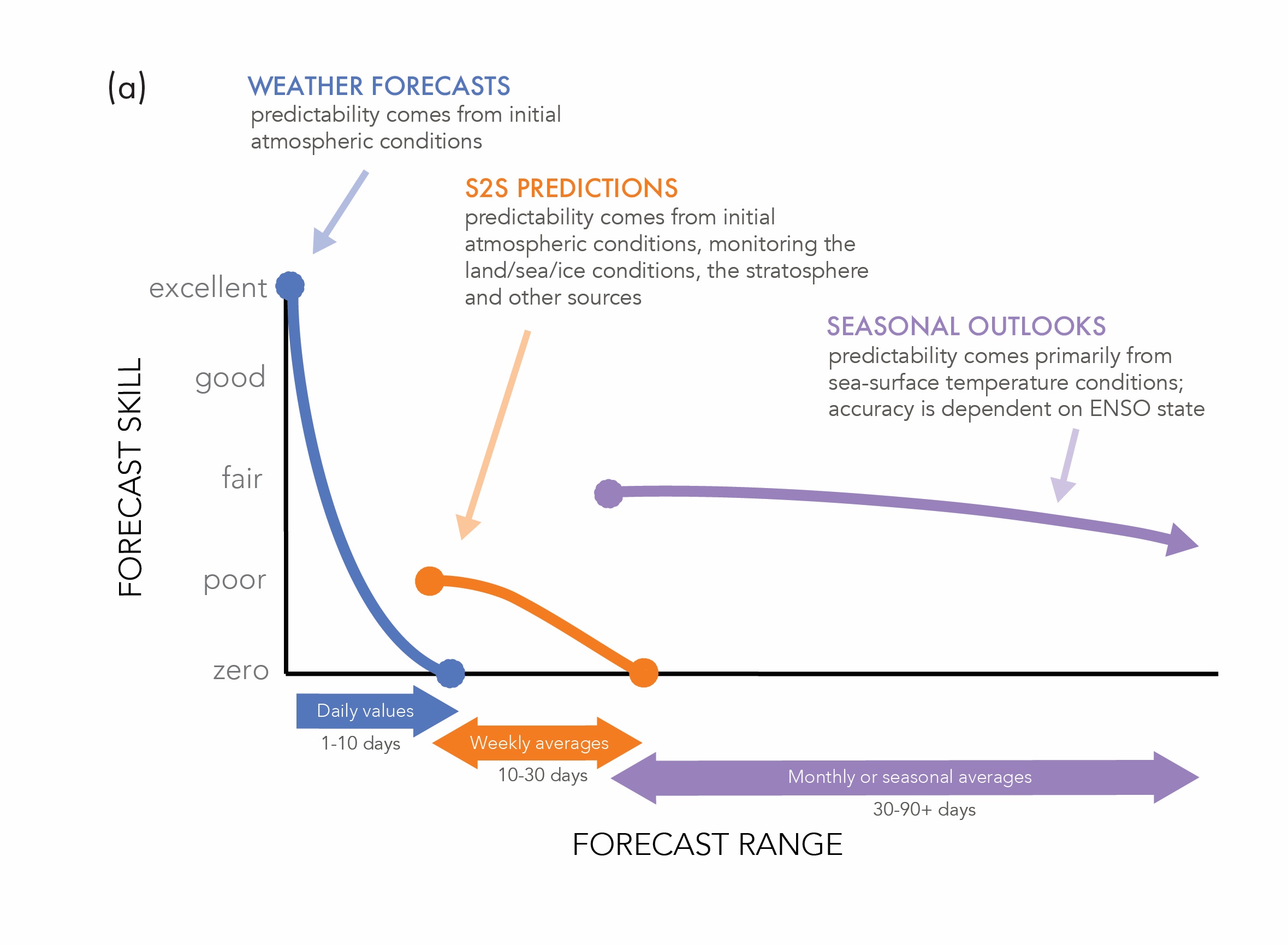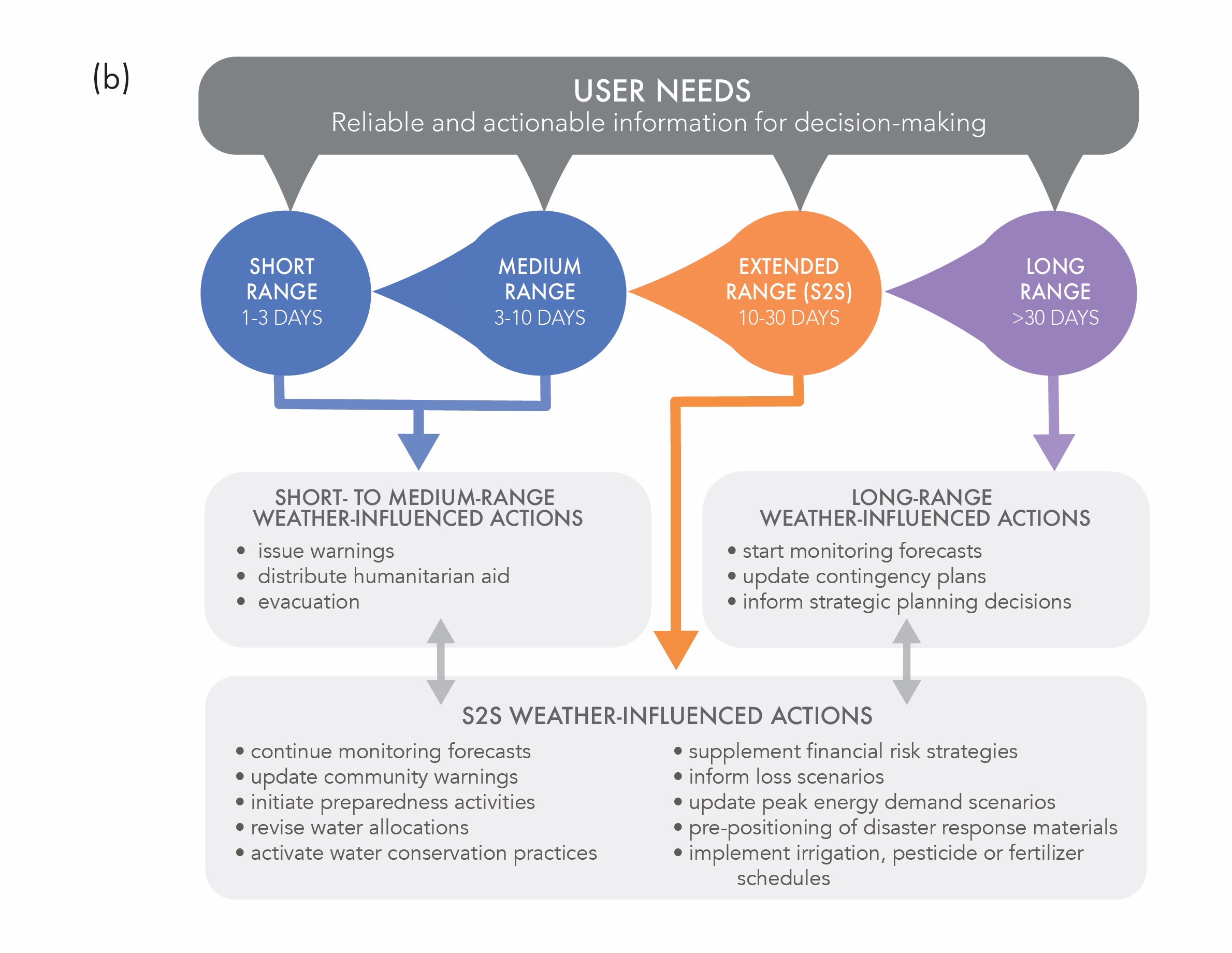Finding a middle ground on hydrological forecasts

Long-range monthly and seasonal outlooks have been operational for many years. However, the extended-range timescale, which sits between the medium to long-range forecasting timescales, has received minimal attention until recently. Our new study aimed to review the potential for applications of forecasts in this range, and found tangible and realistic opportunities for many sectors to systematically plan on this new time horizon.
This timescale has in recent years become referred to as the ‘subseasonal-to-seasonal’ (or ‘S2S’) forecasting range, and is generally regarded as bridging the gap between weather forecasts and monthly or seasonal outlooks.

Qualitative estimate of forecast skill based on forecast range from short-range weather forecasts to long-range seasonal predictions, including potential sources of predictability. Relative skill is based on differing forecast averaging periods.
Once seen as a ‘predictability desert’, recent advances have been made with at least ten international weather centres now having some capability for issuing experimental or operational S2S forecasts. As Dr Debra Hudson from the Bureau of Meteorology noted in a study last year, there is increasing demand for skilful forecasts on the S2S timescale. This interest has been triggered by a combination of growing demand from the applications community, progress in identifying and simulating key sources of S2S predictability, and the recent availability of multi-model S2S forecast datasets such as the WWRP-WCRP S2S database co-hosted by ECMWF and CMA and the NMME.
In our recent cross-disciplinary study, we conduct the first comprehensive review of the potential applications of S2S forecasts. Focusing on potential user applications across a range of sectors, including public health, disaster preparedness, energy, agriculture and water management, the study draws on recent advancements to demonstrate the status and prospects of S2S prediction, highlighting how they can be utilised and where the key challenges remain.
A key to the uptake and usage of S2S forecasts is data availability. The new databases of S2S forecasts – delayed behind real time by three weeks but including hindcasts – present a significant resource that will allow model output to be more widely assessed to identify when and where there is skill, better understand the underlying processes and model weaknesses, and develop applications that can support decision-making on the S2S timescale.
The study also shows how social sciences should be integrated with S2S development – from communication to decision-making and valuation of forecasts – to enhance the benefits of ‘climate services’ approaches for extended-range forecasting. To achieve this, decision-makers and forecasters need to collaborate to determine essential S2S forecast attributes, including identifying appropriate thresholds and their usefulness in decision-making, as well as their economic value. This involves the inclusion of realistic and unbiased messages on forecast skill (or lack thereof), potential usefulness and quantified uncertainties to manage expectations, as well as the continued integration of S2S as a key component in the concepts of seamless prediction and co-production.

A schematic diagram highlighting the relationship between the subseasonal-to-seasonal (S2S) ‘extended-range’ forecast range and other prediction timescales, with examples of actionable information that can enable decision-making across sectors. Actions are examples only and are not exclusive to a forecast range.
The paper concludes that while the uptake and integration of S2S forecasting into decision-making is neither easy nor straightforward, there now exists a growing repository of untapped predictive information that presents tangible and realistic opportunities that can be explored for application-ready capabilities that could allow many sectors to systematically plan on this new time horizon.
Article: ‘Potential applications of subseasonal-to-seasonal (S2S) predictions’, White, C.J., Carlsen, H., Robertson, A.W., Klein, R.J.T., Lazo, J.K., Kumar, A., Vitart, F., Coughlan de Perez, E., Ray, A.J., Murray, V., Bharwani, S., MacLeod, D., James, R., Fleming, L., Morse, A.P., Eggen, B., Graham, R., Kjellström, E., Becker, E., Pegion, K.V., Holbrook, N.J., McEvoy, D., Depledge, M., Perkins-Kirkpatrick, S., Brown, T.J., Street, R., Jones, L., Remenyi, T.A., Hodgson-Johnston, I., Buontempo, C., Lamb, R., Meinke, H., Arheimer, B. and Zebiak, S.E., Meteorological Applications, doi:10.1002/met.1654
Poster presentation: The paper will also be presented as a poster in ‘CL3.01 Climate Predictions – from monthly, seasonal to decadal time scales’ at the EGU General Assembly in Vienna, Austria, 23-28 April 2017
